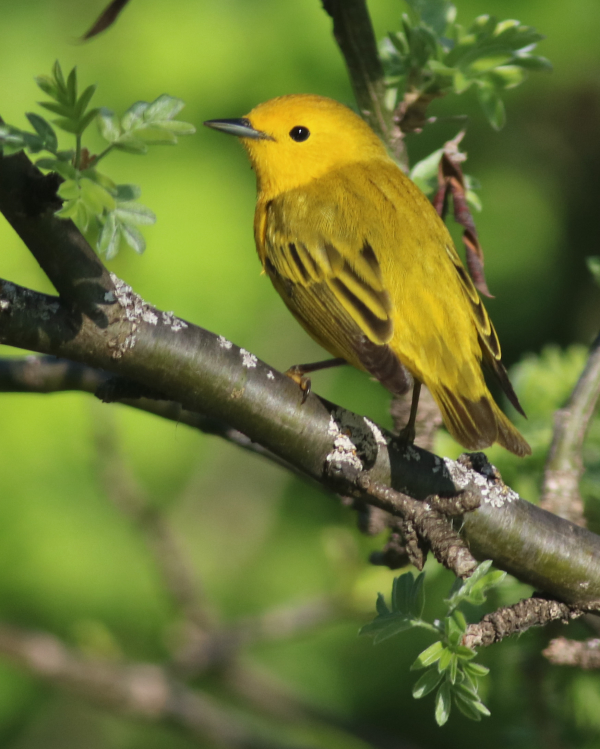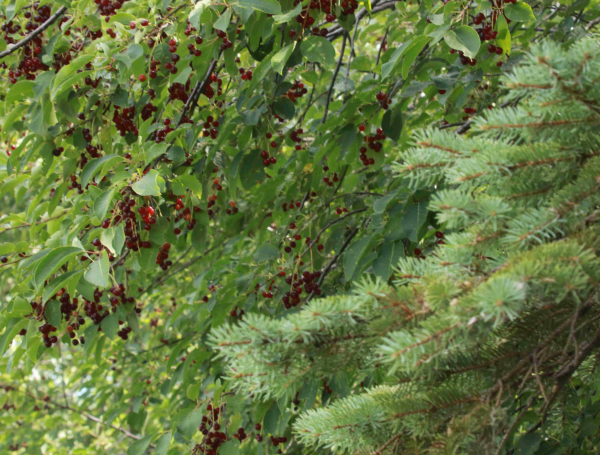
A variety of birds benefit from the birders’ landscaping elements, ranging from trees and bushes to cover species and flowering plants. Migrating songbirds, flycatchers, native sparrows, woodpeckers, and more will benefit from backyard landscapes across the country (Yellow Warbler photo by Paul Konrad).

Different elevations of plants offer different structure for birds as cover, foraging areas, nesting sites, and roosting locations. Tree trunks, branches, and leaves or needles provide foraging locations for a variety of birds, as does ground cover and adjacent open areas.

Make your yard attractive for you, your family and guests as well as for birds by mixing a variety of landscaping elements that may include pine trees and deciduous trees and bushes that add different shades of color and textures. Also consider how plants change with the seasons – bushes that flower in the spring provide berries in late summer and fall, as well as protective shelter throughout the year.
|
August is a great time to add plants to your backyard mix in time to give new plants a good start at getting their roots established and getting some growth on before cold weather and shorter daylight periods prevail. As you take a creative look at your yard, its landscaping and other elements, consider emphasizing “Structure” for birds. Landscaping structure comes in many forms, but think a variety of elevations, different textures, varied shades of green, different colors.
Structure can even mean filling in some empty spaces with plants that will improve the look for you and guests, while improving your backyard habitat for birds. For example, if you have some bushes that have grown upward, leaving their lower branches bare, you can add a new lower level of plants that can provide another level of cover, a foraging area, or a touch of color to liven up your view. You could use low creeping junipers, a row or section of ferns, or a new native flower plot to add different textures and structure. You can add structure by avoiding straight lines and rectangles too – plant with curves and ovals to add a more natural edge to your landscaping elements.
Of course, trees add structure in many ways, whether it’s a single tree or a little stand of three or four trees planted together as aspens or birches might grow in the wild. And speaking of aspens and birch trees, their light-colored bark and paler-green leaves will add color structure to a darker green background. Blending deciduous and coniferous trees also adds a lot of texture variations, as well as shades of color. Even just among pine trees, the differences between blue spruce and black spruce or Douglas fir can add a dramatic change to a yard.
Different ages of trees will show and provide structural differences too. Tree branches certainly add structures that provide perches, and even anchor nests for birds in season. Try to leave any branches in place that might die – dead wood and the food options it creates is attractive to a variety of birds. Then too, there’s always the seemingly extreme option of planting a snag, a large dead branch anchored vertically in the ground. Snags can be decorative is you find the right one, and you will find that many birds use them as preferred perches, as well as foraging sites for woodpeckers, nuthatches, creepers and other birds.
Beyond Trees
Consider letting grass (your lawn) or other plants grow up tall around the base of trees, thereby providing another level of vegetation and source of cover. You might also like letting a smallish area of grass grow tall and seed as a stand of decorative grass, which is pretty during the green season, but also during the fall and winter when the taller grass will turn into a yellow stand.
Bushes offer a lot of variety for landscaping options, and they clearly add another level of structure. Like your trees, you can have areas of coniferous bushes as well as the more traditional deciduous bushes. You can trim bushes, but rather than the straight-edged hedge trim, consider a more contoured trim that may have multiple levels and depths. Some bushes produce flowers and berries, and you can even keep some ornamental trees trimmed shorter to more of a bush height to add structure.
Vines can provide a nice texture among your landscaping, and they can vary from trumpet vines that are hummingbird favorites to wild grapes, or even domestic grape varieties. The leaves add to the look of your landscaping, and it’s well worthwhile to add a few patches of trumpet vines, grapes, or another vine you fine pleasing. You can even run vines up a given tree, or along a fence to give it a more natural look, thereby adding to the structure of your yard.
Balconies, Patios, and Decks Too
Just as structure can be created and changed in different areas of your yard, structure can be used in small spaces too, such as a balcony, patio, or deck; even on the edges of a garage or driveway. You can use varied plant structure to break up empty spaces, and to add interest and beauty to otherwise open areas.
In the case of an apartment or condo balcony, a couple different kinds of plants can add elements of elevation, texture, color, and structure. You can even place special emphasis on the use of planters or pots that balcony plants are contained in, showing off some artistry and varied styles that will make your space more inviting to you and guests, as well as hummingbirds if you include a potted trumpet vine. You can also use pots and planters on a deck or patio, making the plants you choose versatile as you rotate and re-arrange them over time – month to month, week to week, or season to season. Potted plants can also add areas of interest among your landscaping, and some people add a couple potted plants to the edges of their feeding station to add another element of color and vegetation.
Overall, keep in mind that every yard counts as potential bird habitat. We can improve our yards for birds while we make them more pleasing for ourselves, our family, neighbors, and guests. Every yard counts as the cumulative effect of robust landscaping provides shelter, cover, roosting sites, foraging areas, and more benefits a remarkable variety of birds through neighborhoods, towns, and rural areas across the continent and beyond. Every year, try to enhance your yard to continue to provide a special place for everyone to appreciate, including resident, migrating, nesting, and wintering birds.
Share your backyard birding experiences and photos at editorstbw2@gmail.com